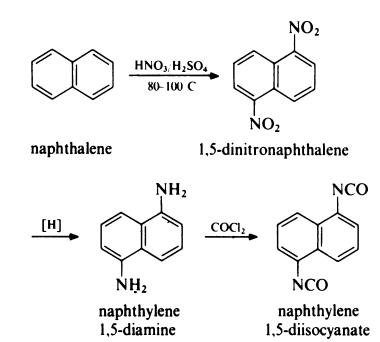Naphthylen-1,5-diisocyanat Chemische Eigenschaften,Einsatz,Produktion Methoden
ERSCHEINUNGSBILD
WEISSE BIS HELLGELBE KRISTALLE.
CHEMISCHE GEFAHREN
Zersetzung beim Erhitzen unter Bildung giftiger Rauche (Stickstoffoxide, Kohlenmonoxid, Isocyanat-Dämpfe, Spuren von Cyanwasserstoff). Reagiert mit Säuren, Alkoholen, Aminen, Basen, starken Oxidationsmitteln, starken Reduktionsmitteln, Wasser.
ARBEITSPLATZGRENZWERTE
TLV nicht festgelegt (ACGIH 2005).
MAK: Sensibilisierung der Atemwege; Krebserzeugend Kategorie 3B; (DFG 2005).
AUFNAHMEWEGE
Aufnahme in den Körper durch Inhalation des Aerosols und durch Verschlucken.
INHALATIONSGEFAHREN
Verdampfung bei 20°C vernachlässigbar; eine gesundheitsschädliche Partikelkonzentration in der Luft kann jedoch beim Dispergieren schnell erreicht werden, vor allem als Pulver.
WIRKUNGEN BEI KURZZEITEXPOSITION
WIRKUNGEN BEI KURZZEITEXPOSITION: Die Substanz reizt die Augen, die Haut und die Atemwege.
WIRKUNGEN NACH WIEDERHOLTER ODER LANGZEITEXPOSITION
Wiederholte oder andauernde Inhalation kann asthmatische Beschwerden hervorrufen.
LECKAGE
Verschüttetes Material in abdichtbaren Behältern sammeln. Reste sorgfältig sammeln. An sicheren Ort bringen. NICHT in die Umwelt gelangen lassen. Persönliche Schutzausrüstung: Atemschutzgerät, P2-Filter für schädliche Partikel.
R-Sätze Betriebsanweisung:
R20:Gesundheitsschädlich beim Einatmen.
R36/37/38:Reizt die Augen, die Atmungsorgane und die Haut.
R42:Sensibilisierung durch Einatmen möglich.
R52/53:Schädlich für Wasserorganismen, kann in Gewässern längerfristig schädliche Wirkungen haben.
S-Sätze Betriebsanweisung:
S26:Bei Berührung mit den Augen sofort gründlich mit Wasser abspülen und Arzt konsultieren.
S28:Bei Berührung mit der Haut sofort abwaschen mit viel . . . (vom Hersteller anzugeben).
S38:Bei unzureichender Belüftung Atemschutzgerät anlegen.
S45:Bei Unfall oder Unwohlsein sofort Arzt zuziehen (wenn möglich, dieses Etikett vorzeigen).
S61:Freisetzung in die Umwelt vermeiden. Besondere Anweisungen einholen/Sicherheitsdatenblatt zu Rate ziehen.
Beschreibung
Naphthalene diisocyanate (NDI) occurs as white to lightyellow
crystalline flakes with a characteristic odor. NDI is
incompatible with many classes of compounds, reacting
exothermically to release toxic gases. Reactions with amines,
aldehydes, alcohols, alkali metals, ketones, mercaptans, strong
oxidizers, hydrides, phenols, and peroxides can cause vigorous
releases of heat. Acids and bases initiate polymerization reactions.
NDI can react with water to form amines and liberate
carbon dioxide.
Chemische Eigenschaften
Naphthylene 1,5-diisocyanate is a solid, m.p. 128°C. It has a lower vapour
pressure than tolylene diisocyanate and is therefore less toxic in use; it does,
however, have sensitizing properties.
Verwenden
Manufacture of polyurethane solid elastomers.
synthetische
Naphthylene 1,5-diisocyanate (NDI) is prepared from naphthalene as follows:

Allgemeine Beschreibung
White to light-yellow crystalline flakes.
Reaktivität anzeigen
Isocyanates and thioisocyanates, such as 1,5-Naphthalene diisocyanate, are incompatible with many classes of compounds, reacting exothermically to release toxic gases. Reactions with amines, aldehydes, alcohols, alkali metals, ketones, mercaptans, strong oxidizers, hydrides, phenols, and peroxides can cause vigorous releases of heat. Acids and bases initiate polymerization reactions in these materials. Some isocyanates react with water to form amines and liberate carbon dioxide. Base-catalysed reactions of isocyanates with alcohols should be carried out in inert solvents. Such reactions in the absence of solvents often occur with explosive violence, [Wischmeyer(1969)].
Hazard
Irritant. Questionable carcinogen.
Sicherheitsprofil
A powerful allergen. An
irritant. Questionable carcinogen. When
heated to decomposition it emits toxic
fumes of NOx.
Environmental Fate
NDI is a synthetic organic chemical. It is a natural derivative of
primary amines with the general formula R–N]C]O which
does not occur naturally in the environment. At room temperature
it can be a liquid or crystal. It is miscible with alcohol,
diglycol, monoethyl ether, ether, acetone, carbon tetrachloride,
benzene, chlorobenzene, kerosene, and olive oil; however, it
may react violently with alcohol, water, acid, bases, and strong
alkaline materials and tertiary amines and generate enough heat
to self-ignite and release toxic combustion products. NDI is not
readily biodegradable; however, it reacts with water and most
acids producing unstable carbonic acids, which subsequently
decarboxylate yielding relatively chemically inert and insoluble
polymeric urea. While these polyureas are persistent, studies
have indicated that they pose virtually no potential for adverse
impacts on the aquatic environment. Due to hydrolysis in water,
bioaccumulation of NDI is not expected. Since the hydrolysis
products formed are irritants, there is a potential for inhalation
exposure. The degree stability is a function of humidity.
Naphthylen-1,5-diisocyanat Upstream-Materialien And Downstream Produkte
Upstream-Materialien
Downstream Produkte

